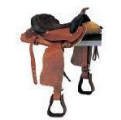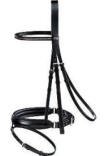
- Saddling & Bridling Your Horse -
Saddling Whether you're using and English or a Western saddle, it is imperative that you use a saddle pad underneath your saddle. If you fail to do so, your horse could get saddle sores and have a sore back. He could also develop raw wounds on his back from the saddle rubbing on his skin. Put the saddle pad on your horse's back so the front of it is over the horse's withers. Make sure it isn't leaning to one side or the other, so one side has more protection than the other. Settle the saddle carefully on top directly in the center of the pad. If it's an English saddle, that should be really easy, considering the shape of the saddle and pad. Be careful that the saddle is centered over the horse's spine to discourage discomfort. Pull up the girth from the other side and attach it properly. To begin with, tighten the girth as far as it will go. The horse might puff up his stomach with air and let it out later to loosen the girth, but this can be dangerous, so always check your girth again once you get out to the riding arena, before mounting. When you get out to the arena, you can pull down your stirrups and adjust them to the length you need. Check your girth once more and tighten it again to prevent the saddle slipping while you're riding. Bridling Always put the saddle on before you bridle your horse. Carry your bridle on one arm by the crownpeice and reins, so the reins won't be dragging on the floor. Approach the horse from the front so that it can see that you've got the bridle in your hands. Try not to let the metal bit clank as you walk, because some horses will react to the noise and then you might have some trouble. When you're bridling the horse, you should always have some means of restraint on the horse's head or neck to stop it from just walking off. Also, be careful not to let the horse get away while you're still putting the bridle on, because it might get its legs tangled in the reins. To start out, untie the horse, then undo its halter. then either wrap a lead rope around its neck or your reins, it they aren't fastened together. Stand on the left side of the horse, take the reins in your right hand, and put them over its head. Then put your right arm underneath the horse's jaw and hold the cheekpeices of the bridle together in front of the horse's face. Hold the bit in your left hand just under the horse's nose. Move the bridle carefully up the horse's face. When the bit touches the horse's mouth, insert your thumb gently between the horse's lips at the corner of its mouth so that it presses slightly on the gum in the gap between the horse's teeth. This will usually encourage the horse to open its mouth. Draw the crownpiece up over the horse's ears, taking care not to let the bit fall out of the horse's mouth. Carefully fit both ears between the browband and the crownpiece and pull the horse's forelock out to that it lies free over the browband. Check that all the parts of the bridle are lying straight and flat before you begin fastening the buckles. First buckle the throatlatch. When it is fastened there should be enough room in-between the leather and the horse's throat to put three finger on top of each other. Any less is too tight and may become uncomfortable for the horse. After that, fasten the noseband. Depending on the type of noseband, it should either be loosely fastened or tight.
|
||||||
|






